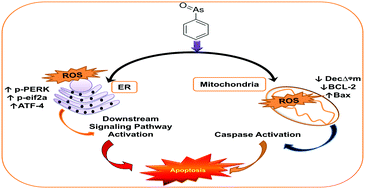Phenylarsine oxide (PAO) induces apoptosis in HepG2 cells via ROS-mediated mitochondria and ER-stress dependent signaling pathways
Abstract
Arsenic trioxide (As2O3) is an old drug that has recently been reintroduced as a therapeutic agent for acute promyelocytic leukemia (APL). Although As2O3 is also applied to treat other types of cancer in vitro and in vivo, it has been reported that single agent As2O3 has poor efficacy against non-hematologic malignant cancers in clinical trials. Recently, a few reports have indicated that organic arsenic compounds can be a possible alternative for the treatment of As2O3-resistant cancers. In this study, we aimed to investigate whether the organic arsenic compound phenylarsine oxide (PAO) has potent cytotoxic effects against human hepatocellular carcinoma (HCC) HepG2 cells. Our results showed that PAO not only had a potent inhibitory effect on the proliferation of HepG2 cells but also activated apoptosis-related proteins (e.g., caspase-3 and -9 and poly-ADP ribose polymerase) in a dose- and time-dependent manner. Furthermore, intracellular ROS were specifically accumulated in the mitochondria and endoplasmic reticulum (ER) after exposure to PAO, implying that they are the target organelles for PAO-induced cytotoxicity. Additionally, when the cells were pretreated with antioxidant N-acetylcysteine (NAC), apoptosis and ER-stress were attenuated significantly, suggesting that induction of apoptosis and cell death probably occurs through the ROS-mediated mitochondria and ER-stress dependent signaling pathways.



 Please wait while we load your content...
Please wait while we load your content...